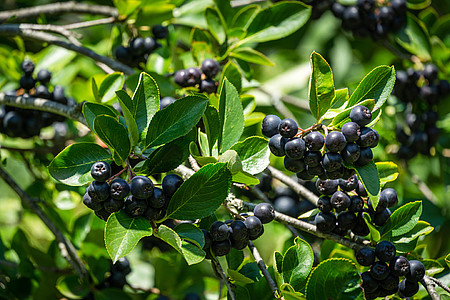Aronia melanocarpa: the black chokeberry
The aronia berry is a shrub or bush-like plant from the rose family, also called Rosaceae. The shrub reaches a diameter of about two metres and has a spherical shape. The aronia berry needs about five years to reach its full size. The plants grow very old and are self-pollinating - if the aronia berry finds good conditions, many can develop from a single bush. Once a year the aronia berry bears fruit: the small aronia berries, about 1 centimetre in size. They have an intense red to dark purple colour and an acidic taste. If the aronia berry is planted in a location with more sunlight, the fruits become sweeter.
The home of the aronia berry
The aronia berry is not a squeamish plant: it grows mainly in the frosty regions of North America and Siberia and is very common there. The forests of northern Canada are considered the home of the aronia berry, which is also known as the aronia berry. It is therefore not surprising that the aronia berry bush can withstand temperatures as low as minus 35 degrees. In the meantime, aronia berry is also cultivated in Europe, in Germany for example in Brandenburg and Saxony, the Sauerland and even in the Rhineland. If you like, you can even plant aronia berry in your garden: it is very forgiving, only waterlogging must be avoided. The high flavonoid content effectively protects the plant against most diseases, pests and environmental influences.
Cultivation and harvesting of chokeberry
From May onwards, the first white blossoms appear, showing the relationship to the native apple tree. These produce the fruits of the Aronia melanocarpa, which can be harvested from around August. The exact harvest time also depends on the growing region - the more southern the location, the earlier the aronia berries are ripe. The berries do not ripen: they can therefore only be harvested when
- both fruits and stems have a deep dark to black colouring,
- the aronia berries are plump to the touch and
- and can be easily removed from the from the bush.
Ingredients of the aronia berry: use as food colouring
Because of its strong red colour, aronia berry is often used as a substitute for food colouring. Incidentally, the berries' deep dark colour is due to their high anthocyanin content. The poisonous prussic acid is also found in the aronia berry - but in such small quantities that aronia berries can be eaten raw without any problems.
This is how the aronia is processed
The berries can only be stored for a limited time and should therefore be eaten or processed quickly after harvesting. They are often dried or pressed into Aronia juice. It is also possible to process the aronia berry into wine or fruit sauces: the finely acidic aroma is a tasty addition to hearty winter cuisine. If you want to consume aronia berry in the form of juice, you should make sure to buy only high-quality pure or pure juice from first pressing. At Rabenhorst, we only use juice from the first pressing for our aronia berry pure juice from first pressing in order to preserve a large number of the valuable ingredients.
FAQ
Can you eat the aronia berry raw?
Besides many vitamins, aronia berries also contain toxic prussic acid. However, this is only present in small quantities, so that eating them raw in moderation is harmless.
How can you process aronia berries?
Aronia berries are good for making jam and juice and taste good dried as an ingredient in pastries, muesli and fruit bars.
What does aronia taste like?
The aronia berry has a fine-sour and slightly tart taste. The sunnier the location of the plant, the sweeter the fruits taste.


